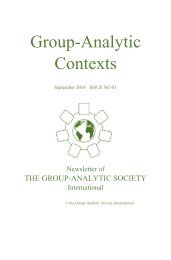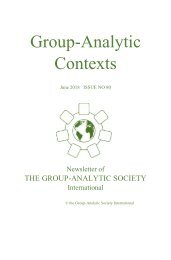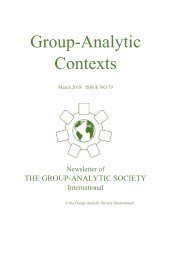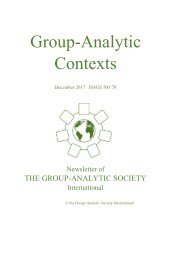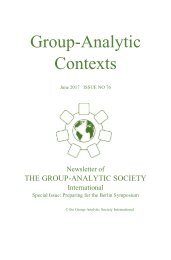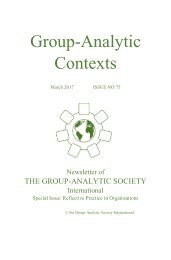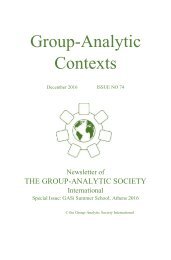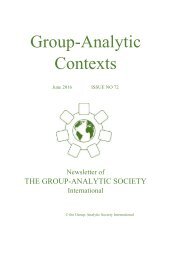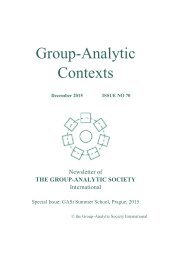Group Analytic Contexts, Issue 77, September 2017
Newsletter of the Group Analytic Society International
Newsletter of the Group Analytic Society International
You also want an ePaper? Increase the reach of your titles
YUMPU automatically turns print PDFs into web optimized ePapers that Google loves.
136 <strong>Group</strong>-<strong>Analytic</strong> Society International - <strong>Contexts</strong><br />
However, it’s astonishing how easily mistakes can be made<br />
through typing errors in this process. You’d be surprised how many<br />
research papers won’t be wrong due to scientific flaws (poor research<br />
design, inappropriate statistics) but because of typing mistakes. These,<br />
and other errors can be easily avoided or rectified.<br />
Here’s a 10-item list how to avoid ‘the avoidable’ during data<br />
collection, entry, analysis, and errors made during manuscript<br />
preparation:<br />
1. Setting up procedures for checking data whilst you<br />
collect them (e.g. checking that all questions in<br />
questionnaires are answered).<br />
2. Dating and signing questionnaires before filing them.<br />
3. Transferring data directly by scanning or directly<br />
downloading them into a statistical package/spreadsheet.<br />
4. Entering data twice (double data entry): after data has<br />
been typed into the database, a blank copy of the<br />
database is then made; the data re-entered and the 2<br />
databases are merged to detect inconsistencies.<br />
5. Writing a data entry protocol (specifying rules for<br />
illegible/ambiguous data).<br />
6. Creating log files (rationale and record with dates of all<br />
analyses, names of files, folders and updating these).<br />
7. Checking the final data set for missing data,<br />
inconsistency (are values of variables likely?) and range<br />
(are values of any variable unlikely?).<br />
8. Programming analysis: Writing a programming code, or<br />
getting a kind statistician over a cuppa to help you, to<br />
include automatic output that’s suitable to be imported<br />
into a word processor, because cutting and pasting<br />
individual numbers from software output is a source of<br />
error.<br />
9. Checking every number on your report against the<br />
printout of statistical software when preparing your<br />
manuscript.<br />
10. Double-checking your final copy to avoid errors at the reformatting<br />
stage.<br />
And finally, taking a deep breath when it’s done. If you get your<br />
matrices right, coherence emerges during the process of your research.<br />
When it all comes together, the data creates a new phenomenon, a<br />
‘suprapersonal research matrix’. It’s just like in the group, when



